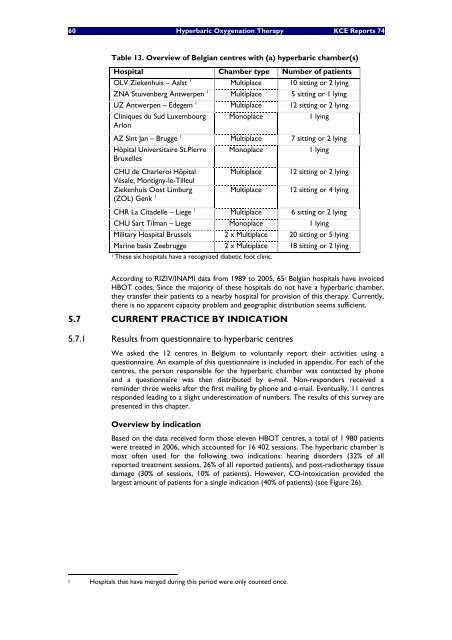Hyperbare Zuurstoftherapie: Rapid Assessment - KCE
Hyperbare Zuurstoftherapie: Rapid Assessment - KCE
Hyperbare Zuurstoftherapie: Rapid Assessment - KCE
You also want an ePaper? Increase the reach of your titles
YUMPU automatically turns print PDFs into web optimized ePapers that Google loves.
60 Hyperbaric Oxygenation Therapy <strong>KCE</strong> Reports 74<br />
Table 13. Overview of Belgian centres with (a) hyperbaric chamber(s)<br />
Hospital Chamber type Number of patients<br />
OLV Ziekenhuis – Aalst 1<br />
ZNA Stuivenberg Antwerpen 1<br />
UZ Antwerpen – Edegem 1<br />
Cliniques du Sud Luxembourg<br />
Arlon<br />
AZ Sint Jan – Brugge 1<br />
Hôpital Universitaire St.Pierre<br />
Bruxelles<br />
CHU de Charleroi Hôpital<br />
Vésale, Montigny-le-Tilleul<br />
Ziekenhuis Oost Limburg<br />
(ZOL) Genk 1<br />
Multiplace 10 sitting or 2 lying<br />
Multiplace 5 sitting or 1 lying<br />
Multiplace 12 sitting or 2 lying<br />
Monoplace 1 lying<br />
Multiplace 7 sitting or 2 lying<br />
Monoplace 1 lying<br />
Multiplace 12 sitting or 2 lying<br />
Multiplace 12 sitting or 4 lying<br />
CHR La Citadelle – Liege 1<br />
Multiplace 6 sitting or 2 lying<br />
CHU Sart Tilman – Liege Monoplace 1 lying<br />
Military Hospital Brussels 2 x Multiplace 20 sitting or 5 lying<br />
Marine basis Zeebrugge 2 x Multiplace 18 sitting or 2 lying<br />
1 These six hospitals have a recognized diabetic foot clinic.<br />
According to RIZIV/INAMI data from 1989 to 2005, 65c Belgian hospitals have invoiced<br />
HBOT codes. Since the majority of these hospitals do not have a hyperbaric chamber,<br />
they transfer their patients to a nearby hospital for provision of this therapy. Currently,<br />
there is no apparent capacity problem and geographic distribution seems sufficient.<br />
5.7 CURRENT PRACTICE BY INDICATION<br />
5.7.1 Results from questionnaire to hyperbaric centres<br />
We asked the 12 centres in Belgium to voluntarily report their activities using a<br />
questionnaire. An example of this questionnaire is included in appendix. For each of the<br />
centres, the person responsible for the hyperbaric chamber was contacted by phone<br />
and a questionnaire was then distributed by e-mail. Non-responders received a<br />
reminder three weeks after the first mailing by phone and e-mail. Eventually, 11 centres<br />
responded leading to a slight underestimation of numbers. The results of this survey are<br />
presented in this chapter.<br />
Overview by indication<br />
Based on the data received form those eleven HBOT centres, a total of 1 980 patients<br />
were treated in 2006, which accounted for 16 402 sessions. The hyperbaric chamber is<br />
most often used for the following two indications: hearing disorders (32% of all<br />
reported treatment sessions, 26% of all reported patients), and post-radiotherapy tissue<br />
damage (30% of sessions, 10% of patients). However, CO-intoxication provided the<br />
largest amount of patients for a single indication (40% of patients) (see Figure 26).<br />
c Hospitals that have merged during this period were only counted once.

















